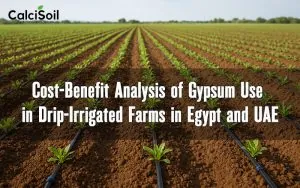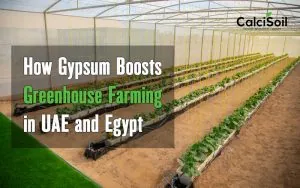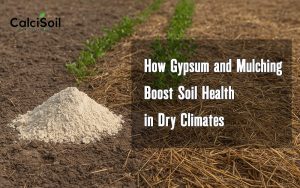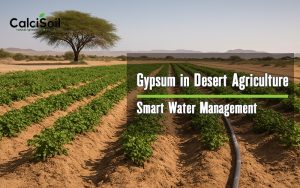
Gypsum effects on plants
Effect of Agricultural Gypsum on Improvement of the Nitrogen, Phosphorus and Potassium in Leaves and Seeds under Salinity Stress
Introduction
Gypsum, a naturally occurring mineral composed primarily of calcium sulfate dihydrate (CaSO₄·2H₂O), plays a significant role in agriculture, particularly in managing soil salinity and enhancing plant growth. Salinity stress, often exacerbated by the use of saline irrigation water, poses a considerable challenge to crop production. High salinity levels create an osmotic pressure that restricts water uptake by plants and disrupts nutrient balance, leading to reduced plant growth and yield.
This article explores the effects of agricultural gypsum on improving the nitrogen (N), phosphorus (P), and potassium (K) content in plant leaves and seeds under conditions of salinity stress.
Salinity Stress and Its Effects on Plants
Saline irrigation water increases the osmotic pressure in the soil, leading to several detrimental effects on plant health:
- Nutrient Imbalance: High salinity levels shift the selective absorption of ions by plant roots, often resulting in an accumulation of sodium (Na) and a reduction in essential nutrients such as phosphorus (P), potassium (K), and magnesium (Mg) in plant tissues.
- Reduced Growth: The excess sodium interferes with the absorption of potassium, which is crucial for various physiological processes. This imbalance can lead to stunted growth, leaf burn, and overall poor plant development.
- Soil Degradation: Continuous irrigation with saline water can degrade soil quality over time, rendering it unsuitable for agricultural use due to high salt concentrations.
Research indicates that as salinity increases, the concentrations of nitrogen, phosphorus, and potassium in plant leaves decrease significantly. This reduction adversely affects plant health and productivity, necessitating effective management strategies to mitigate these impacts.
Role of Gypsum in Ameliorating Salinity Stress
The application of gypsum serves as an effective strategy to counteract the adverse effects of salinity on plants:
1. Improvement of Soil Structure
Gypsum enhances soil structure through a process known as flocculation. When applied to saline soils, gypsum reacts with sodium ions, replacing them with calcium ions. This ion exchange helps to reduce sodium concentrations, improve soil aggregation, and enhance water infiltration and drainage. Improved soil structure facilitates better root growth and nutrient uptake by plants.
2. Nutrient Availability
Gypsum not only provides calcium but also improves the availability of other essential nutrients in the soil. The presence of calcium helps counteract the negative effects of excessive sodium on nutrient uptake. Studies have shown that gypsum application increases the levels of nitrogen, phosphorus, and potassium in plant tissues, thereby enhancing overall plant nutrition. Furthermore, sulfur present in gypsum aids in reducing the Na/K ratio, promoting better absorption of potassium and phosphorus.
3. Mitigation of Salinity Effects
Calcium plays a crucial role in mitigating salinity stress by enhancing nitrogen metabolism and photosynthetic activity in plants. By reducing sodium absorption while increasing potassium uptake, gypsum helps maintain a favorable K/Na ratio within plant cells. This balance is vital for sustaining cellular functions under saline conditions.
4. Environmental Benefits
Gypsum is a naturally occurring mineral that poses minimal environmental risks when used in agricultural practices. Its application contributes to sustainable land management by improving soil health without introducing harmful chemicals into the ecosystem.
Conclusion
The use of agricultural gypsum presents a promising solution for improving nutrient content in plants affected by salinity stress. By enhancing soil structure, increasing nutrient availability, and mitigating the adverse effects of high salinity levels, gypsum supports healthier crop growth and improved yields.
As agricultural practices continue to confront challenges posed by salinity and nutrient imbalances, gypsum application stands out as an effective method for reclaiming saline soils and ensuring sustainable agricultural productivity.
In summary, integrating gypsum into agricultural practices can significantly alleviate salinity stress impacts on crops while promoting better nutrient uptake and overall plant health. Future research should focus on optimizing gypsum application rates and exploring its synergistic effects with other organic amendments to maximize benefits for crop production under saline conditions.







